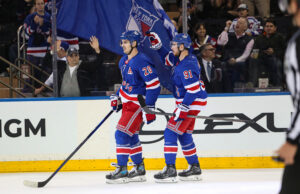Games with fans are not on the horizon. Team revenues are in crisis and expenses are rising. Through a pandemic and major lawsuits, the CHL is pushing forward. If it is to be successful, it has to provide a safe environment for hockey players and families at the rink and beyond. The CHL is in crisis.
The third in a 3-part series.
- Less Money, More Problems: why the CHL may need a bailout.
- Lawsuits and Legal Fees
- Moving Forward Without Making it Worse
Part 3. Moving Forward Without Making it Worse
CHL teams are hoping to play. Currently in a terrible position, not making the situation worse will be challenge. There is a desire from the league to play, how that might look is difficult to imagine.
The QMJHL has proposed an adapted plan for returning to hockey. They are targeting an October 1st start which seems unrealistic. If Wal*Mart in the United States is giving up their annual Black Friday in November, that minor hockey would have the means to play seems unlikely. Not with the CHL in crisis, that is.
The plan from Quebec is beginning to acknowledge that travel costs are going to be a major issue. Every effort will need to be taken to keep costs down,and even that may not be enough. At this point, even the start of the 2021-22 NHL season’s planned January start is in jeopardy. If that ends up being the case, minor hockey can only wait.
A Safe Environment for Junior Hockey
The CHL is for junior hockey players. They are not adults. The league is trusted by the parents of players to help raise their kids, and that means a considerable amount of trust in the teams. They have not always shown they deserve that trust historically, which has resulted in multiple major lawsuits. Team busses are chalk full of teenage hockey players. This environment is not conducive to social distancing.
The players below the age of consent especially need consideration. Society protects them from themselves under normal circumstances. They are teenagers. In the Covid environment this responsibility changes dramatically. Suddenly we need to consider two seats to one person on the bus, and reduced sharing of hotel rooms. Gym usage, practices, education, and many other hurdles are going to prove logistical quagmeiers.
Proximity Alert
If social distancing is not possible, alternatives are few. The only safe way to keep teams together would involve significant Covid testing. For MLS, NHL, and the NBA it’s a very costly issue. The NHL’s return to play bubble is expected to surpass 25-30,000 tests at $125 per test (Per SI.) As their commissioner, Gary Bettman declared, expectations are to render that number of tests “insignificant.” That easily puts the figure above $4 million on testing alone. That is for a smaller number of teams who can happen to afford to rent entire hotels with tunnel access to rinks. The professional sports leagues are also getting priority testing for Covid, which is no guarantee for the CHL in crises.
Issues of money aside, it must be remembered these athletes are human. Especially for non-professional leagues the question must be asked if it is even worth playing. Many professional athletes have contracted Covid. Superstar baseball player Freddy Freeman revealed this week he prayed for his life while he was sick. Is the hockey world prepared to accept that a junior hockey player might experience the same fate or worse? It must be a difficult question.
Family Matters
Worse is what parents of players must ask themselves. Per a poll analyzing parents feelings in Ontario about back to school, “43 per cent said they were uncomfortable or somewhat uncomfortable with the idea.” (Via CTV.) Will parents be prepared to consent to sending their kids to play hockey?
Across Canada, debates are taking place about how to send kids to school and if it is possible right now. For parents of players, they must decide if they are ok with sending their child to live in a different city. Parents of non-athletes are currently wondering if they can have their kids in school next year.
Attending school at all is a major question. Some CHL parents they must ask themselves if they can ask their kids to live in the USA. With a pandemic and events like unmarked officers snatching people off the streets of Portland, it’s a difficult call. Sorry to American readers, but it’s not a great environment to send your kid.
Participation in Question?
Families must ask if teams can guarantee player safety. If parents are not satisfied with the CHL’s plans, they may not allow their players to participate. This would of course be devastating to young players and would no doubt be a difficult call for many families. Unfortunately, this is reality during a pandemic.
The series of lawsuits pertaining to injury and abuse are concerning enough. If safety players risk getting sick, will families and players be able to opt out? It would be a difficult call for a hockey household. Hopefully nobody will be put in that position. If they are, this could potentially lead to future lawsuits down the line.
Recapping the CHL in Crisis Problems
The Canadian Hockey League (CHL) faces a series of crises that they may not be able to overcome. Even in an ideal world, running minor hockey without fans would cause teams to crumble. Teams are in serious financial problems due to the current global pandemic.
Teams also may not be able to operate. Problems are adding up including Covid-19 hot spots, a border that looks set to be shut well into 2021, lawsuits, and expenses that cannot be handled. This has created a serious problem for junior hockey in Canada.
Bailing Out Settlements
The CHL may very well be able to entice governments to provide a bailout. Given the cultural importance of junior hockey, them getting money seems plausible. The Irvings for example a proven ability to obtain government money. As well, governments across Canada have shown a willingness to spend in pandemic times.
In theory, a government bailout could be both useful and supported by the public. That said, can the government give a bailout to the CHL if they have to spend the money on legal fees and settlements? This would be a much tougher sell to the public.
The league is working through a cultural shift. The focus on the health of athletes through the concussion lawsuit could change future actions. The suit focused on abuse could force many current people from the hockey world to experience a reckoning they never expected.
Change is Coming to the CHL in Crisis
At this point, the CHL is planning on having a season. This raises questions. Can they do this? Should they do this? Players no doubt will want to play, but will families and governments be in position to allow them to do so? It is not clear, and there is no timeline on obtaining clarity. Even if they do return, that in of itself may create greater problems.
Bordering into unfathomable, this storm of problems may force a new model for junior hockey. With so many economic, social, and practical problems to solve, the CHL may not be able to do much more than wait until Covid reaches an end. At that point, they can pick up the pieces caused by a CHL in crisis.
Main Photo:






